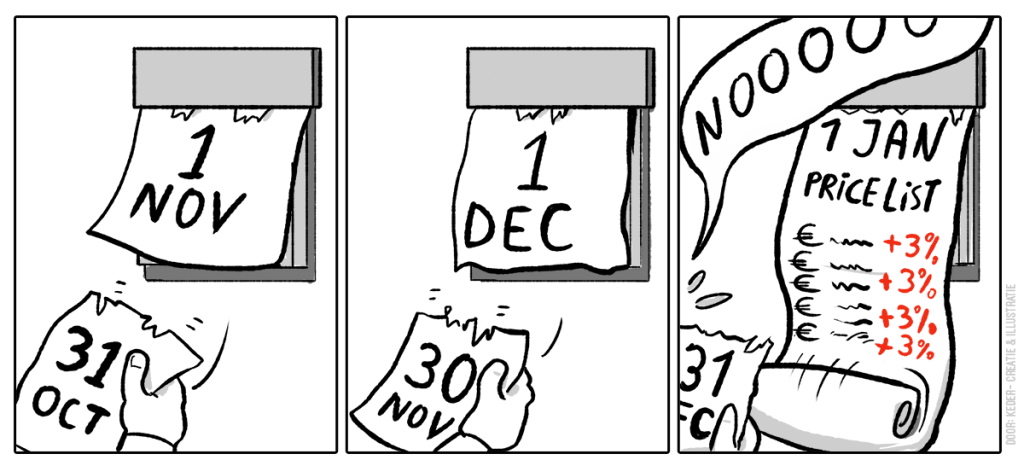On January 1st everything is suddenly more expensive due to random price increases. Because…? There were fireworks? Are we putting up a new calendar? Did someone hear a champagne cork pop?
It seems like some sort of culturally decided habit, but as it often is with culture: what was the motivation behind these random price increases? In the old days production companies innovated so much in the interest of the entire industry, that it was righteous to share some of the costs. But is this still the case? It is time to challenge two apparent truths:
(1) manufacturers innovate and; (2) everything is always getting more expensive.
1. Manufacturers innovate
How many manufacturers still truly excel at innovation; and successful improvements that add value to the chain? Other than an electric car or smart screen, for a while, it has not been the products that surprise us anymore, it’s the (r)etailers and data giants, like Amazon, Google, Facebook, and Alibaba. There’s no traditional manufacturer that can keep up with their innovation speed. No old money can compete with the new.
Visit a traditional fair and you will need a magnifying glass to find true innovation. Sorry, but a new color (usually white) or a new packaging (also usually white) doesn’t count. Who is winning the innovation awards? Not the big brands from the old days. At the awards where I was a judge myself, it was no exception that we had to call around, to give the amount of innovative entries a little bit of volume: “Didn’t you think of something new… yeah, not that it will ever sell, but in terms of idea it does classify as innovation. Apply quickly, I think you might have a shot…”
2. Everything is always getting more expensive
As soon as you start growing you achieve efficiency and the costs per unit decrease. If you’re not growing, you have an entirely different problem. Besides, professional companies can learn and do things more smartly. Employees have one more day of experience after each work day and if you happen to make a mistake, you can prevent that later. Besides that, the exchange rate of commodities is rather relevant.
As a general rule, within a manufacturing company between 40% and 60% of the cost price is determined by (purchasing of) materials. But these prices sometimes increase and sometimes decrease. Who’s to say? You don’t even need to be a good purchaser to decrease costs or, as we like to call it, earn money.
A numeric example. Imagine you’re purchasing duvet covers under the following conditions:
- price € 10
- volume 100.000
- guaranteed 1 year
- increase 1-1 + 3%
- Growth + 10%
- commodities -/- 2%
In 3 years you will pay €3,406,080 in total and on average €10.32 for a duvet. But if you approach this fact-based and you put the changes to your advantage, the growth will give you an advantage because of the larger coverage on fixed costs, then you’re not going to pay those random price increases of 3% and are entitled to a part of the 2% decrease in commodity costs. And the time that you didn’t have access to all this information is long gone, isn’t it?
In this example, you would pay an average of €9.59 in 3 years, and that is 7% less! The total over 3 years is then 3,163,282 and no less than €242,000 lower than in traditional purchasing. You shouldn’t make a deal with the supplier who happens to give you the best offer, but with the supplier with whom you think you can negotiate best (and most honestly).
Because as soon as commodity prices increase, suddenly a manufacturer’s attitude changes: “We have a problem, you may see everything, we’re very transparent”. Yes, of course now they are! The price increases, and as a client you should pay this for me. When it decreases, everything is for the manufacturer, but with increases, we expect partnership through good and bad times.
But what we forgot was that the exchange rate at the beginning of 2014 went towards $1.40, and then importing was almost free. My response as a purchaser: okay, you want to attach the dollar exchange rate to the price I pay. That’s okay. But let’s make a deal that we’re going to do that for the next 10 years. We attach the new purchasing price to the exchange rate and for the next years, in good and bad times, we will follow the exchange rate and adjust the prices accordingly. Fair deal?
Furthermore, I suspect that the supplier has employed a few good purchasers who can handle market fluctuations well. They have the choice to either safeguard, buy in a different currency, or speculate. That is their own choice. But speculation means taking risks and it often goes well (supplier earns more) and sometimes it doesn’t (client pays for a failed gamble…).
The same thing applies to the purchasing of commodities. You can be tough and add an attachment to a certain exchange rate in your contract, but beforehand you won’t know if you will profit from the purchasing advantages your supplier obtains. It is much smarter to just appeal for that, in the warm partnership you have. Only then you’re cooperating honestly.







